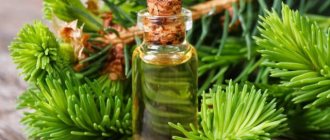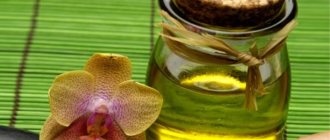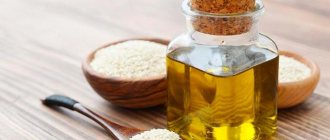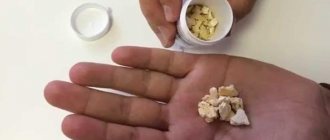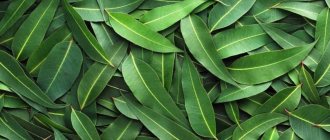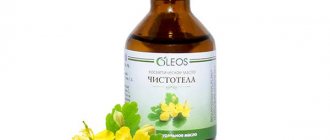Dill oil: application features and better recipes
Dill is rightfully considered a plant with truly unique properties. Products containing this additive are often used not only in cooking, but also in medicine - both official and folk. What is dill oil and what is it for?
Dill oil has a complex of beneficial properties that make it an almost unique preparation. Experts note its calming, antispasmodic, and antibacterial effects.
Let us analyze these points in more detail. This remedy can be used as a sedative. With its help, feelings of anxiety are reduced, general tension in the body is eliminated, and depression is treated.
This effect allows the oil to be used to normalize sleep.
In addition, it is a good antispasmodic. The use of the product allows you to relax muscles, nerve endings, normalize breathing, and the effect occurs quite quickly. It relieves cramps and spasms, which can cause a person a lot of unpleasant sensations, and in especially severe cases lead to more negative consequences.
In addition, dill essential oil can be used to disinfect abrasions and cuts; it has the ability to protect a person from bacteria and infections.
In medicine, this drug is used to normalize the functioning of the urinary and reproductive systems, as well as to reduce gas formation. With its help you can stimulate the digestive process and the formation of gastric juice. It is also known to have a positive effect on diseases of the stomach and intestines.
Since the oil has an antibacterial effect, it can be used for gastritis and stomach ulcers, where this property is especially important. The diuretic effect allows this product to remove excess water and harmful substances from the body, helps remove swelling and lowers blood pressure.
In addition, the product works very well for various skin diseases.
Nursing mothers have long taken dill decoction to increase milk supply.
Oil based on this product is an effective replacement; in addition, when it enters the child’s body, it has a positive effect on the functioning of the delicate ventricle, which will help relieve colic and relieve gas formation.
Despite the huge number of advantages of this product, in some cases it must be used with caution or completely abandoned. First of all, dill oil is contraindicated for expectant mothers. Its use can lead to fetal bleeding and death. It is also necessary to take into account that the drug lowers blood pressure.
It should not be used if you have epilepsy. In addition, if you are allergic to dill, you should also avoid using the oil.
Dill essential oil can be used both externally and internally. Let's look at particularly active areas of application.
Since dill oil has a relaxing and calming effect, it is often used in massage treatments. They are carried out both entirely on certain areas of the body, and pointwise. To normalize sleep and get rid of insomnia, just take a few drops of oil and massage your back or calf muscles with it.
The work of the intestines will be facilitated by massaging the abdomen in a clockwise direction. It is also a very effective remedy for flatulence. If a person is worried about the kidneys or pancreas, it is recommended to massage this area. For liver diseases, massage of the soles of the feet will help; for headaches, you need to treat your temples by placing one drop of oil on them.
Before you start taking dill oil this way, experts recommend talking to your doctor.
To get rid of flatulence and colic, this remedy must be diluted with cool water in proportions of 1:10 and drunk 3 times a day, 2 teaspoons.
For poor appetite, add 1 drop of oil to a glass of water and consume 1 tablespoon throughout the day. The same proportions are used when it comes to indigestion.
If we are talking about diseases of the urinary and reproductive systems, dill oil should be taken regularly - 5 milliliters twice a day before meals. In cases where the wounds are inflamed, they should be treated with a solution containing 3 drops of the product per glass of water. The procedure should be repeated periodically.
One drop of oil per day applied to the wart will help get rid of this unpleasant formation.
The benefits of dill from its use in cooking are not in doubt. At the same time, dill oil can also be used for food, however, its specific smell must be taken into account. This remedy will also help in the fight against blood-sucking insects. They do not like the aroma of dill essential oil, so cotton balls soaked in the composition will help get rid of mosquitoes.
It can also reduce the discomfort of bites.
It is impossible to make essential oil from dill at home, but making a tincture or infusion is quite possible. Today, let's look at recipes for making oil from the seeds of the plant. The most widely used method is in which dried dill seeds are thoroughly crushed, for which you can use a blender or mortar.
The resulting powder is poured into a container and filled with sunflower or olive oil in equal parts. The mixture should be thoroughly mixed and stored in a dark place indoors for 2-3 weeks. For a stronger effect, the composition must be stirred every day, and after the allotted time has elapsed, it must be strained and squeezed.
Homemade dill oil is then considered ready.
The second method is less common, however, the product obtained on its basis is no less high quality, although more narrowly focused.
An equal amount of crushed dry dill seeds and fresh lard is taken, mixed and applied as an ointment. You can also make oil from fresh dill.
We suggest considering 2 manufacturing options; the resulting product can be used both for food and cooking, and for treatment.
So, in the first case, fresh herbs are mixed with butter, salt and a small amount of lemon juice. For those who like it spicy, it would be a good idea to add grated garlic. This healthy delicacy can be used for sandwiches, as well as as an addition to a variety of dishes.
In the second case, the dill must be washed and dried thoroughly, then minced in a meat grinder and the juice squeezed out through a gauze mesh. The resulting liquid is evaporated until its volume is half as much.
Add juice in equal proportions to boiling vegetable oil, then cool and pour into a convenient container.
It should be noted that this composition can be used for medicinal purposes, the main thing is to shake it well before each use.
Watch the video to learn how to make dill oil at home.
Source: https://eda-land.ru/maslo/ukropnoe/
Useful properties and contraindications
Dill oil is obtained from the seeds or green part of the plant. Used for both internal and external use.
Here are just a few cases when dill ether will be useful:
- helps cope with colds;
- in the treatment of respiratory organs (used as an inhaler);
- helps to calm down during times of stress;
- treats pathologies of the genitourinary system;
- helps normalize stool;
- eliminates bad breath, removes and prevents the appearance of plaque;
- has a disinfecting effect;
- stimulates milk production during lactation.
The ether has a pleasant aroma, which when inhaled has a relaxing and calming effect. Stimulates tissue regeneration, so it is used as a wound healing agent for abrasions, burns and cuts. This is an excellent natural remedy to combat:
- with headache;
- impaired metabolism;
- pathologies of the cardiovascular system;
- asthma;
- poor appetite.
But not everyone can use this product, including contraindications:
- children under three years of age;
- epilepsy;
- perinatal period.
If you have chronic diseases, you should definitely consult a doctor before using dill oil!
How to make dill oil?
Dill is a plant that is used in many sectors of our life, from cooking to traditional medicine.
Humanity has known about its properties for a very long time, and therefore, it is not surprising that many want to know whether it is possible to make dill oil at home.
Let's figure out today how to make dill oil with your own hands without outside help.
1
Properties of dill
Before you start making the oil in question, it is imperative that you familiarize yourself with all the healing properties of dill and its effect on the body.
Today we will not talk about the mass that is obtained from dill by distilling it with essential oil, but rather about the oil extract of this plant. Its main properties are:
- It is taken as an antiseptic that can perfectly disinfect and also heal various kinds of cuts, wounds and other external defects of the skin.
- It can easily cope with various skin diseases, including various types of herpes.
- Many people take this oil as a prophylactic against viral infections. If you lubricate the mucous membranes with this oil in cold weather, the risk of getting sick in the near future is significantly reduced.
- But this does not mean at all that it can be used only for external use; if you suddenly experience constipation or are experiencing spasms in the gastrointestinal tract, dill oil is an excellent remedy to get rid of the problems in question.
- If you have a headache, all you have to do is massage with the remedy in question, and you will forget about the migraine for a long time.
- The remedy in question is often used in aromatherapy; this oil relieves a person of headaches, anxiety and frequent attacks of aggression.
Among other things, dill oil can be taken even by young mothers who are breastfeeding their babies, because the remedy in question provokes an increase in the lactation process.
2
Making your own dill oil
It is clear that to obtain high-quality dill oil we will need the seeds of this green plant.
You can get them at the market, in a pharmacy (this is an excellent remedy against bloating in small children) or collected from the garden (the season for collecting is late summer, early autumn).
In principle, the time to collect seeds depends on the variety of dill and the time when it was planted.
To prepare dill oil, you will need to go through the following processes:
- The first step is to dry the dill seeds. This must be done without fail. It’s not enough that you just picked them from the garden and brought them home. It is necessary to spread them on paper (you can use ordinary newspaper for these purposes) in a thin layer and place them in direct sunlight for a short time, a few days will be enough.
- Once they are completely dry, put them in a coffee grinder. If you don’t have one, you can use a blender for the purposes in question. In folk medicine manuals, it is mandatory to crush dill seeds manually.
- Now the seeds, crushed to powder, must be filled with vegetable oil (either olive or sunflower oil). In this case, the proportions must be observed exactly; here they are 1:1.
- The ingredients must be mixed in a glass container, mixed well and left in this form for about 6-7 days, and the jar will need to be shaken every day.
This mixture must be stored at room temperature; you won’t have to put it in the cold, but you should find a place where the sun will not shine.
3
Application of dill oil
As you can understand from the above information. Anyone who has the necessary ingredients and a glass jar can prepare this oil. There is nothing complicated in this process.
If you don’t want to spend money on buying dill seeds, don’t be lazy and collect them at the end of summer at your dacha or other plot of land where they grow. If you don’t have your own garden, ask a neighbor for permission to collect seeds.
It should also be noted that the oil in question is an excellent remedy for gastrointestinal problems during fasting.
The fact is that each body reacts differently to the transition to plant foods, so some problems with the stomach, pancreas, etc. may arise.
So, regularly taking dill oil will help cope with the problems under consideration, and will also help your body quickly adapt to a new type of food.
For those who are not in the know, collecting dill seeds is carried out as follows:
- First you need to find a plantation where dill will grow.
- Find overripe plants, because it is on them that you can find the seeds that we need to prepare dill oil.
- Let us immediately note that no other elements or parts of dill can be suitable for achieving the goal in question, that is, obtaining dill oil. It is a misconception that the remedy under discussion can also be obtained from the stems of this plant.
- Now take some container or a wider plastic bag, and bring the collection container to the lush cap of the plant, on which the seeds are located.
- Gently shake any existing seeds from the head and move on to the next plant.
There is nothing complicated about boraxing such seeds if you have where to collect them, and preparing such oil is very simple, so you should not have any problems with this process.
Source: https://sovetclub.ru/kak-sdelat-ukropnoe-maslo
How to make your own essential oil?
Many people are interested in how to make dill oil at home so that it turns out to be of high quality and healthy. To prepare it, you need to pour 1 tbsp. crushed dill seeds to the top with vegetable oil, leave for a week in a dark place, stirring the seeds periodically. Then strain the resulting product through cheesecloth and squeeze well. It must be stored in the refrigerator for 2 years.
Dill oil can be made at home in another way. To do this, you need to wash the leaves and seeds thoroughly and dry them on a towel. Grind the resulting raw materials in a meat grinder, squeeze the juice from the green mass through cheesecloth. Boil the resulting juice over low heat until it reduces in volume by half. Boil vegetable oil and let cool. Then mix the oil and dill juice in equal proportions and let it brew.
Knowing how to make dill oil at home, you can prepare a high-quality, natural product that will have all the required healing properties.
Dill oil at home: how to make it, what it can be used for, video
Dill oil is a very useful remedy in many areas of application: for certain diseases, in everyday life, for weight loss, etc. Let's consider why it is so useful and how to prepare it at home.
The benefits of dill oil
Fragrant spicy dill contains essential oil (about 4%), B vitamins, folic acid, iron, carotenoids, flavonoids, potassium and calcium salts.
To obtain essential dill oil, plants must be collected when the seeds have reached milky maturity. The umbrellas are cut and then processed by hydrodistillation.
Dill seeds and its oil are contained in many medicinal preparations, which have a sedative, expectorant, choleretic, and laxative effect.
They promote digestion, improve and stimulate milk production in nursing mothers, have antispasmodic, antibacterial and analgesic properties, and work as a vasodilator and coronary dilator.
How to make dill oil at home
Making healthy dill oil with your own hands at home is very simple. The most popular cooking recipe is described below:
- We take last year's dill seeds and put them in a deep jar.
- Pour heated vegetable oil to the brim of the jar, which should not be very hot.
- Mix the resulting mixture thoroughly and place it in a warm place for a week, stirring thoroughly every day.
- After 7–10 days, express the mixture using several layers of gauze. At first, the liquid will be gray due to the large number of suspended dill particles. After a day, the dill will settle, forming a sediment, but there is no need to drain it. The color will become darker than the original, with a slight greenish tint.
A small amount of oil is diluted with water and drunk.
Features of application
Due to its healing properties, dill oil is quite popular and is used in many areas. It is widely used in cooking, medicine, cosmetology, perfumery, and everyday life; it effectively helps in the fight against excess weight.
When cooking, the oil is used in a similar way to freshly picked spices. It is especially relevant in the winter season, when fresh greens are practically absent from the diet. It is used as a flavorful additive in cooking, used for various dishes: soups, salads, meat and fish delicacies, added to marinades, sauces and baking dough.
For medical purposes, dill oil is used in the following cases:
- diseases of the throat and lungs with dry cough;
- suffocation during asthma;
- gout;
- atherosclerosis;
- motion sickness and seasickness;
- lipid metabolism failures;
- pain during menstruation, severe menopause;
- stones in the kidneys;
- constipation and bloating.
This remedy, obtained from dill, boasts a calming and emotional-relieving effect, and is also relevant for use in psychotherapy and relieving anxiety.
Internal use
For flatulence and constipation, it is recommended to make a solution of 1 tsp. butter for 5 tbsp. l. boiled water. The product is thoroughly stirred and consumed 1 tbsp. l. after eating. This procedure must be repeated 3 times a day until the condition stabilizes. To reduce colic, infants can be given 1 drop before feeding.
Important! Before you start giving your baby dill medicine, do not forget to consult your pediatrician.
For vegetarians and those people who fast, the dill product will be very useful. The fact is that when switching to eating plant foods, the body often experiences discomfort, disorders and flatulence.
This remedy will relieve painful symptoms and return the body to normal. If you suffer from a dry, asthmatic or cold cough, you can use the following recipe. Pour 1/2 a pipette filled with oil onto a piece of bread or refined sugar, place it under the tongue and gradually dissolve. Treatment is carried out for a week, 2 times a day.
If various allergic reactions have occurred in the past, you must first do a tolerance test.
At home
In everyday life, dill product is used in some aftershave products (soothes the skin) and in dental products (performs a whitening function). It is also used in mouth rinses to freshen breath. In addition, dill oil is present in air purification products and as a mosquito and midge repellent.
Important! As a sedative, it can be used by dripping into an aroma lamp 2
–
3 drops.
For inhalation, use a mixture of 5 drops of dill and 5 drops of chamomile oils. Since this product is a natural preservative and has a spicy odor, it is used in various industries: food, perfume, and alcoholic beverages.
For weight loss
The product described will be an excellent assistant for those who want to adjust their weight and lose weight, since it effectively and gently relieves hunger. To reduce appetite, speed up metabolism and cleanse the body of waste and toxins, you need to dissolve 6 drops of the product in 1 tsp. honey. The product should be taken in the afternoon and at night.
To reduce body weight, at the same time as taking it orally, it would be useful to take aromatic baths and also do a massage.
To take a bath with essential oils, you need to take 2 drops of dill and cypress oil and 1 drop of rosemary, mix them with an emulsifier, which can be salt, honey or soda, and then pour into warm water, the temperature of which is +36...+38° C.
Take this bath for no more than 20 minutes. Massage using dill effectively helps remove fat accumulation in problem areas of the body (abdomen, thighs, buttocks).
Contraindications and possible harm
There are only 3 contraindications for using dill product:
- epilepsy;
- individual intolerance;
- pregnancy.
The uniqueness of this product is that when applied to an area of skin, no discomfort is felt. In addition, it is non-toxic and can be used in slightly larger dosages than other essential oils. In sealed packages it is stored for 2 years without losing its healing properties.
Source: https://fermer.blog/bok/ogorod/ukrop/polza-ukropa/primenenie-ukropa/3044-maslo-iz-ukropa.html
Characteristics of the oil and how it is produced
Dill
Dill is rich in volatile elements, so essential oil is mainly obtained from it. Depending on the type of production, it is made from the seeds or stems of the plant. But the fruits contain more of it. The natural substance is so soft and fragrant that it is even used in cosmetic procedures.
The harvested raw materials are pre-dried, and then steam distillation is used. As a result, it turns out colorless or with a yellowish tint. The smell is also different from the plant, but the freshness remains. It resembles cumin: a sweet and pleasant aroma. But if only leaves are used, the aroma of the plant can be preserved. This oil has a higher cost and quality. It is better to choose it than from stems, seeds or a combination. You can find it at the pharmacy.
For weight loss
The product described will be an excellent assistant for those who want to adjust their weight and lose weight, since it effectively and gently relieves hunger. To reduce appetite, speed up metabolism and cleanse the body of waste and toxins, you need to dissolve 6 drops of the product in 1 tsp. honey. The product should be taken in the afternoon and at night.
To reduce body weight, at the same time as taking it orally, it would be useful to take aromatic baths and also do a massage. To take a bath with essential oils, you need to take 2 drops of dill and cypress oil and 1 drop of rosemary, mix them with an emulsifier, which can be salt, honey or soda, and then pour into warm water, the temperature of which is +36...+38° C. Take this bath for no more than 20 minutes.
Massage using dill effectively helps remove fat accumulation in problem areas of the body (abdomen, thighs, buttocks).
Did you know? In ancient Rome, very often the winners of various competitions were presented with wreaths made of dill.
How to use dill oil
Dill oil is used in various fields, although it is more often remembered in connection with culinary recipes. Dill oil was known as a medicinal product in ancient times: it was well known by the Egyptians, Greeks, Jews and Romans. We are accustomed to believe that the distillation method was discovered by Avicenna in the 11th century, but it appeared much earlier - back in Ancient Mesopotamia, so even Roman gladiators, going to the arena, rubbed themselves with dill oil to strengthen their strength and calm their nerves at the same time. For these purposes, dill oil is also used in modern medicine: it helps relieve the effects of stress and mental stress, collect your thoughts and look at yourself from the outside. It is interesting that in the Middle Ages, when the Inquisition was raging in Europe, numerous monks used dill oil to suppress sensuality and pacify their flesh.
Composition and production of essential oil
Dill fruits contain many essential oils, and are often obtained from this part of the plant. However, the green part of dill also contains many oils. The oil extracted from the greenery of the plant is characterized by a spicy aroma and greater softness, and that is why it is used in cosmetology.
The composition of dill oil is quite unstable. This largely depends on the period of fruit harvest and many other factors. The product consists mainly of terpenes, as well as carbon, which gives it a fairly persistent and spicy aroma. It is quite difficult to obtain dill oil at home by steam distillation. For this purpose, the steam distillation method is used. Before distillation, the raw material is dried, since it must be light, liquid, and also completely transparent.
